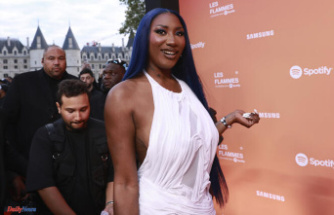Marilyn Monroe was only granted 36 years on earth - on August 4th, exactly 60 years ago, Norma Jeane Baker died. In her 15 years in front of the camera, however, she appeared in more than 30 films: from her debut in 1947 in The Shocking Miss Pilgrim to the unfinished work Something's Got to Give in 1962, the year Monroe died. Most of the time she played the role of the head-turning, naïve blonde. A part that she knew how to cultivate like no other and use to her advantage, but which was always a thorn in her side.
Even the discovery of the young Norma Jeane is ready for Hollywood. In 1944, at the end of World War II, she was working in an armaments factory. Under the propaganda program "Rosie the Riveter", photogenic women in the armaments industry were supposed to ensure female growth and at the same time keep the male soldiers happy. A year later she had the model contract in her pocket, another year later she was signed to the film studio 20th Century Fox.
The local talent scout Ben Lyon then gave her the stage name Marilyn, and she supplied the perfectly fitting surname herself - Monroe, her mother's maiden name. So the sonorous name was found, but the sonorous roles were a long time coming until the 1950s.
Only as an extra or in tiny roles, Monroe began her career in front of the film camera. Her first speaking role was simply the two words "Hi, Rad!" in the comedy "Scudda Hoo! Scudda Hay!". Even in "Dangerous Years" it wasn't enough for more. As a result, her contract with the film studio was not renewed and Monroe was sent back to acting school - and to her hair.
Her hair, which was bleached anyway, had to become even blonder, her flawless teeth even more flawless with braces. Monroe's willingness to comply with the superficial demands of her new film studio Columbia Pictures apparently paid off: the film title "I dance into your heart", Monroe's first leading role, in which she was immediately allowed to show off her singing voice, literally hit her and the cinema audience.
With her new appearance, however, she was immediately forced to marry a certain image of women - that of the naive and cheeky, but at the same time beautiful, blond silly. Whether in serious films like "Asphalt Jungle", the tragic comedy "Everything about Eva" or the romantic comedy "We're not married at all".
It was all the more surprising that she celebrated her international breakthrough as the exact opposite. Although still lascivious and blonde, she planned her husband's murder in "Niagara" as a true femme fatale with deep cunning. However, the film remained an exception: in the musical "Blondes are preferred" together with her song "Diamonds Are a Girl's Best Friend" and "How do you catch a millionaire?" their roles were knitted more simply again.
Her name may have preceded Monroe by this time. She was only partially happy about the reason for this. On the one hand, she was honored as the world's most popular actress at the 1954 Golden Globes. On the other hand, she begged the decision-makers at (now again) 20th Century Fox to finally give her more demanding roles.
The supposed compromise: The leading role in Billy Wilder's "The Seven Year Itch", the strip that delivered one of the most famous scenes in cinema history: Marilyn Monroe over a subway shaft through which her dress seems to develop a life of its own. An iconic moment that even gave rise to a technical term - updrafts on skyscraper facades are still referred to today as the "Monroe effect".
When the term "method actor" is mentioned, most people think first of Daniel Day-Lewis (65) and probably never of Marilyn Monroe. But it was precisely this acting philosophy that she pursued at the height of her career in the mid-1950s. For the western drama "Bus Stop" she had specially trained a southern accent. With the British production "The Prince and the Dancer" she was even responsible as a producer with her in-house film company Marilyn Monroe Productions.
But the more Monroe tried to break out of her gilded cage of popular but meaningless roles, the more she was thwarted. Yes, the reviews for her performance on "Bus Stop" rolled over the edge. However, the film was not a commercial success. And due to a lack of public interest, "The Prince and the Dancer" remained the first and only film that Monroe produced himself.
Her ambitions were not rewarded. A frustrating realization for the star, who had to let it sink in first. 1958 is the only year in the actress's career when she did not appear in any films. And when she got back in 1959, she did it in the usual way, which she didn't like.
She shot again with Billy Wilder: "Some Like It Hot", known in this country as "Some Like It Hot", quickly became Monroe's biggest hit. Her role in it: that of the naïve blonde, ukulele player Sugar Cane, who is looking for a rich man and falls doubly for impostor Joe (Tony Curtis).
Monroe was no stranger to the male gaze throughout her career. In "Some Like It Hot" this male view of her body, captured through the camera lens, was almost perfected. Monroe, the star with a built-in gaze magnet - whether she wanted it or not...
Again and again it is said to have cracked on the set of "Some Like It Hot". At this point, Monroe was already suffering from a pill addiction and self-doubt. She had trouble remembering the lines and was often late for filming. Then the great stroke of fate: the actress, who was pregnant at the time, lost her child during the film production.
Did it feel like mockery for Monroe that she received her first and only acting Golden Globe for "Some Like It Hot" of all things? Pictures of the award ceremony in 1960 show her beaming and in a good mood. But don't forget: Marilyn Monroe was a great actress.
She was allowed to prove it one last time on the screen in the western "Misfits - Not Socially Acceptable" alongside Clark Gable. It is the final work that she was able to complete before her death. Above all, her role, the dancer Roslyn, wants more respect and wants to be seen and appreciated by men not just as an object, but as a person. The parallels to her own life were obvious - and the ambitious film was once again a commercial failure.












